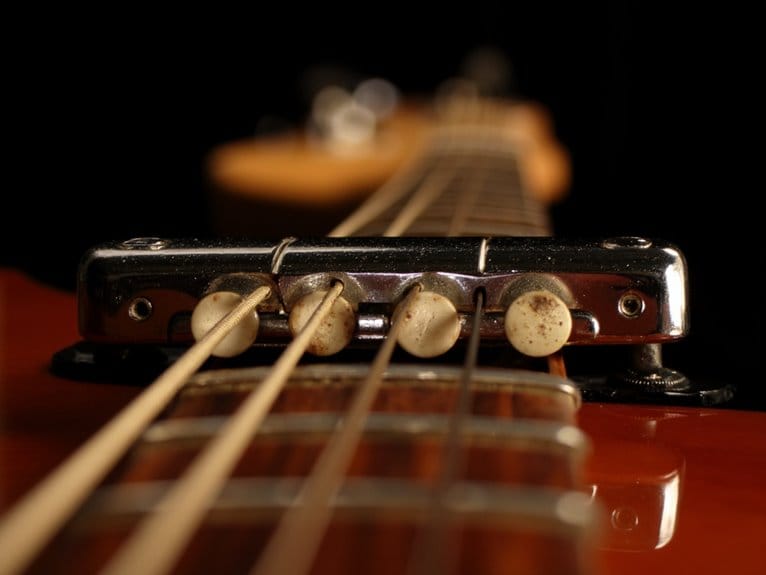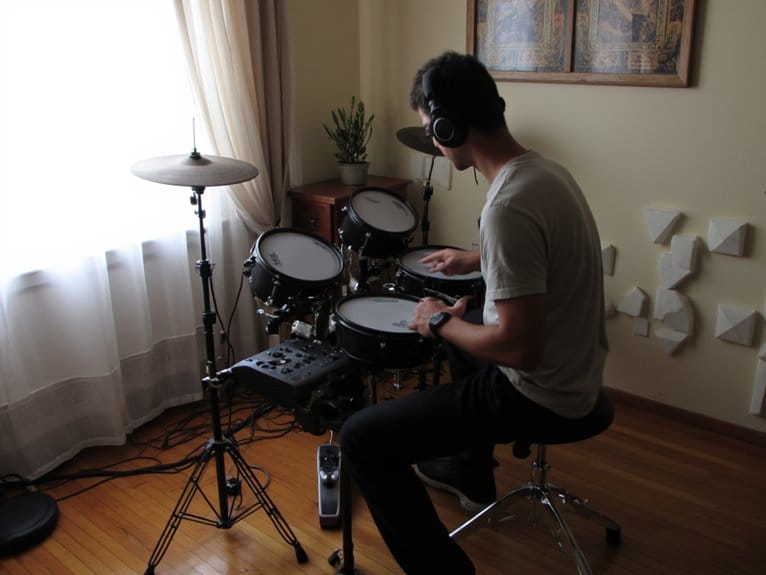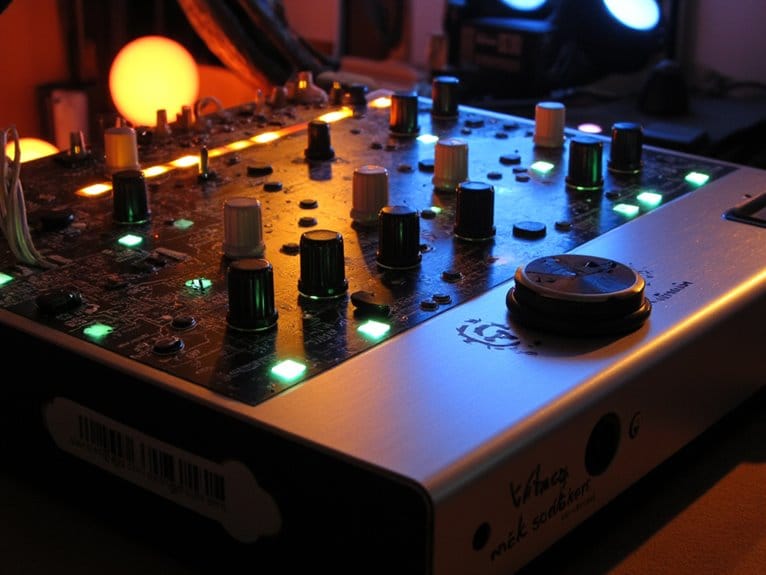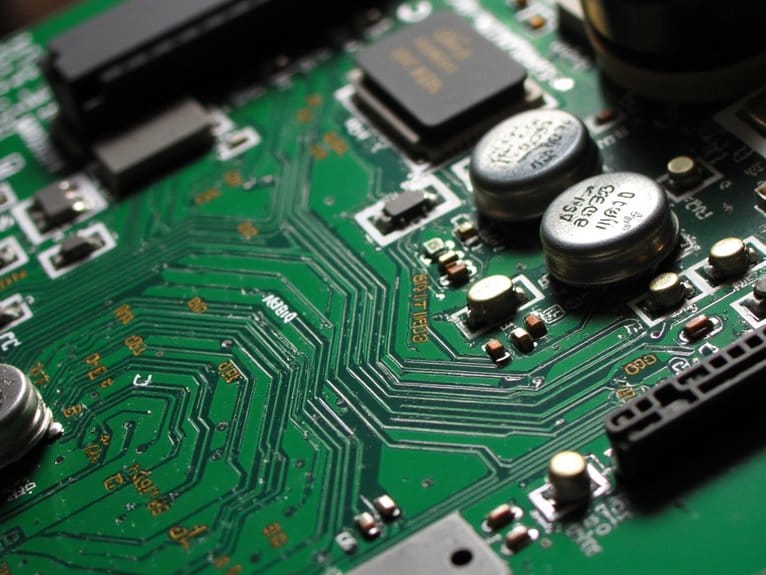Understanding Bass Guitar Action and Setup Basics
Bass guitar action refers to the string-to-fretboard distance, typically measured at 2.4mm for low E and 2.0mm for high G at the 12th fret, though you’ll want to adjust this based on your playing style and comfort preferences. Proper setup involves coordinating string height through bridge saddle adjustments, neck relief via truss rod tweaks, nut slot filing, and intonation corrections to guarantee accurate pitch across the entire fretboard—and mastering these interconnected elements transforms any mediocre bass into a professional-grade instrument.
We are supported by our audience. When you purchase through links on our site, we may earn an affiliate commission, at no extra cost for you. Learn more.
Notable Insights
- Action is the string-to-fretboard distance at the 12th fret, affecting playability, comfort, and tone quality.
- Measure action with capo at first fret; target 2.4mm for low E and 2.0mm for high G strings.
- Neck relief should be approximately 0.25mm at 8th fret to prevent buzz while maintaining low action.
- Adjust bridge saddles with 1.5mm hex key in small increments, retuning after each change for accuracy.
- Proper intonation ensures 12th fret notes match open strings; adjust saddle position to correct pitch discrepancies.
What Is Bass Guitar Action and Why Does It Matter
Every bassist, whether you’re just starting out or you’ve been playing for decades, eventually encounters the concept of action—that essential measurement between your strings and fretboard that can make or break your playing experience.
Action refers to the distance between your strings and the frets, typically measured at the 12th fret, and it’s arguably one of the most critical factors affecting how your bass feels under your fingers. This measurement directly impacts everything from your playing comfort to your instrument’s sound quality, influencing both your string selection preferences and tone shaping capabilities.
Action significantly influences playability and tone, making it a crucial element for both novice and seasoned players. Proper action setup reduces hand fatigue during extended playing sessions, allowing you to maintain consistent performance throughout lengthy rehearsals or gigs.
Lower action makes fretting easier but risks buzz, while higher action requires more effort but often delivers richer sound with better dynamics and cleaner articulation. String sustain can improve with higher action settings, as excessively low action often leads to energy loss when strings contact the frets.
How to Measure and Adjust String Height
Now that you understand what bass action is and why it matters, you’ll need to learn the practical skills of measuring string height accurately, making precise bridge saddle adjustments, and testing your results through careful fine-tuning.
I’ve found that most players underestimate how much proper measurement technique affects their setup success, since even small miscalculations can lead to frustrating buzzing or uncomfortably high action that makes playing feel like a workout.
You’ll discover that mastering these three interconnected processes—measuring with the right tools and technique, adjusting saddles methodically, and testing your changes through both measurement and playability—forms the foundation of achieving that perfect balance between low, fast action and clean, buzz-free tone. Remember that new guitars typically come with deliberately high action settings to prevent fret buzz during initial testing, so most players will need to lower their string height after purchase for optimal performance.
Measuring String Height Accurately
Three critical measurements can make the difference between a bass that fights you and one that practically plays itself.
However, I’ve learned that most players either skip this step entirely or measure incorrectly, which explains why so many instruments feel comfortable despite expensive setups.
Your string action measurement requires specific setup techniques that I’ve refined through years of adjustments:
- Position the bass neck parallel to the ground while measuring at the 12th fret, using a capo at the first fret to eliminate nut height variables that can skew your readings.
- Measure from the fret top to string bottom using a string action gauge or precision ruler, targeting 2.4mm for your low E and 2.0mm for high G strings.
- Take multiple measurements after confirming proper tuning, since string tension directly affects height accuracy and consistency.
Just as directional microphones require precise positioning within 3-6 feet for optimal performance, your measuring technique must be consistent to achieve reliable results.
The neck profile significantly impacts how string height feels during play, with C-shaped profiles offering enhanced comfort across different playing positions and techniques.
Remember that initial setup adjustments are often necessary even for new instruments, as most basses require fine-tuning to achieve optimal string height for your playing style.
Bridge Saddle Adjustments
The bridge saddle represents your most direct control over string height, and I’ve discovered that understanding this adjustment mechanism transforms frustrating setup sessions into precise, predictable outcomes that consistently deliver professional results.
You’ll need a 1.5mm hex key for most bridges, inserting it into the saddle’s height adjustment screws on the leading edge. Turn clockwise to raise saddle height, counterclockwise to lower it, but here’s where I see players mess up – adjust both screws simultaneously to maintain proper string alignment.
Work string by string, re-tuning after each adjustment because tension changes affect your measurements. I’ve learned that keeping saddles parallel prevents spacing issues, while using a radius gauge helps match your fingerboard’s curvature for consistent playability across all strings.
Testing and Fine-Tuning
Getting down to the nitty-gritty of string height measurement requires the right tools and technique, because I’ve seen too many players struggle with inconsistent readings that lead them down frustrating adjustment rabbit holes.
You’ll need a proper string action gauge or precision ruler, and positioning matters more than most realize.
Here’s my tried-and-true measurement process:
- Set up correctly – Tune to standard pitch, clamp a capo at the 1st fret, and hold your bass in playing position.
- Measure at the 12th fret – Place your gauge between the fret top and string bottom on both E and G strings.
- Compare to standards – Target 2.4mm for low E, 2.0mm for G string.
Neck Relief and Truss Rod Fundamentals
Now that you’ve got your string height dialed in, you’ll need to understand how neck relief works with your truss rod, since these adjustments form the foundation of your bass setup before you can properly set action at the bridge.
I’ve learned that neck relief refers to that slight forward bow in your neck that’s created when string tension pulls against the truss rod’s counteracting force, and getting this relationship right prevents fret buzz while maintaining playable action.
You’ll discover that adjusting your truss rod isn’t just about turning a wrench, but rather understanding how small quarter-turn increments can solve relief problems and create the best playing surface your bass needs.
What Is Neck Relief
When I first started learning about bass guitar setup, neck relief struck me as one of those mysterious concepts that every experienced player mentioned but rarely explained clearly.
Simply put, neck relief refers to the slight concave bow in your bass neck, a carefully controlled neck curvature that compensates for string vibration amplitude.
Here’s what neck relief accomplishes for your bass:
- Prevents fret buzz by providing clearance for vibrating strings over the fretboard
- Balances string tension against the truss rod’s counter-force to maintain ideal playability
- Enables lower action without sacrificing clean note articulation or sustain
Think of neck relief like stadium seating—the gentle bow creates necessary space for string movement.
Too much relief creates uncomfortably high action, while insufficient relief causes buzzing that’ll drive you crazy during practice sessions.
Even budget instruments can benefit significantly from professional setups that optimize neck relief and transform an entry-level bass into a performance-ready instrument.
Truss Rod Adjustment Process
Before I attempted my first truss rod adjustment, I’ll admit I was intimidated by horror stories of snapped rods and ruined necks, but the reality is that this fundamental setup procedure becomes straightforward once you understand the mechanics and follow proper protocol.
My adjustment techniques start with detuning strings completely, ensuring proper tension management throughout the process. Tool selection proves critical—I always verify the exact wrench size before beginning, since a loose fit can round the truss rod nut.
| Action | Direction | Result |
|---|---|---|
| Clockwise turn | Tighten rod | Straighter neck |
| Counter-clockwise | Loosen rod | Increased bow |
| Quarter-turn max | Either direction | Safe increment |
I make adjustments in small increments while holding the bass in playing position, then retune and measure relief at the eighth fret using my capo-and-feeler-gauge method.
Relief Problems and Solutions
Even with perfect truss rod technique, you’ll eventually encounter relief problems that require deeper understanding of what’s actually happening inside your bass neck. I’ve learned that identifying the root causes separates successful adjustments from frustrating cycles of tweaking.
Relief causes typically stem from three primary factors:
- Environmental changes – humidity and temperature fluctuations cause wood expansion and contraction, constantly shifting your neck’s natural curvature.
- String tension variations – changing gauges or fresh strings alter the pulling force on your neck, requiring compensation adjustments.
- Structural wood characteristics – different wood densities and grain patterns respond uniquely to tension loads.
Relief symptoms manifest as fret buzz with insufficient relief, or uncomfortably high action when there’s excessive bow. This makes accurate diagnosis essential before attempting corrections.
Regular maintenance and proper storage in a protective case prevents many relief issues from developing in the first place.
Just as dual shielding protects signal integrity in quality bass cables, proper neck relief shields your bass from playability issues caused by structural stress.
The Nut’s Impact on Your Bass Setup
The tiny strip of material sitting at the top of your bass neck might seem insignificant, but I’ve learned through countless setups that the nut wields tremendous influence over your instrument’s playability, intonation, and overall performance.
When your nut slot heights aren’t properly adjusted, you’ll encounter string buzz against the first fret or uncomfortably high action that makes fretting notes feel like a workout.
Poor string alignment through incorrectly angled slots creates tuning stability nightmares, while different nut materials affect sustain and tone differently.
I’ve witnessed too many setup errors stem from rushed filing techniques or attempting nut replacement without understanding how the headstock angle impacts string path, ultimately compromising your bass’s potential performance.
Just as a properly cut nut enhances your bass’s natural tone, adding a quality bass preamp pedal with comprehensive EQ controls can further shape and optimize your sound for both live performances and studio recordings.
Achieving Perfect Intonation
After you’ve sorted out your nut issues and eliminated those pesky setup gremlins, you’ll discover that even perfectly adjusted string heights mean nothing if your bass can’t stay in tune across the fretboard.
Intonation correction becomes your next mission, and I’ll admit, it’s where many players throw in the towel prematurely.
Intonation adjustment separates committed players from quitters – it’s technically demanding but absolutely essential for professional-sounding bass performance.
Here’s your systematic approach to achieving pitch accuracy:
- Tune your open strings perfectly using an electronic tuner, then fret each string at the 12th fret.
- Compare the fretted note to your tuner – if it’s sharp, move the saddle backward to lengthen the string.
- Adjust iteratively by loosening or tightening the bridge saddle screws, rechecking your open tuning after each movement.
Perfect intonation across every fret remains impossible due to equal temperament limitations, but nailing the 12th fret reference point gets you remarkably close to musical nirvana.
Once your bass achieves proper intonation, protecting it during transport becomes crucial, especially since impact protection helps maintain your carefully calibrated setup over time.
Essential Tools and Setup Sequence
Precision becomes your greatest ally when you’re ready to tackle a proper bass setup, and I’ve learned the hard way that attempting adjustments with makeshift tools creates more problems than it solves. Professional string action measurements require dedicated gauges that deliver accuracy rulers simply can’t match, while precision straightedges with ±0.0015″ tolerance guarantee proper neck relief assessment.
| Tool Category | Essential Items |
|---|---|
| Measurement | String action gauge, precision straightedge |
| Adjustment | Allen wrenches, Phillips screwdriver |
| Shaping | Specialty files, nut slot files |
| Verification | Digital tuner, feeler gauges |
Quality setup kits from StewMac or Music Nomad streamline the entire process, though basic adjustments remain possible with minimal tools if budget constraints exist.
Fine-Tuning Pickups and Electronics
With your bass properly set up mechanically, you’ll discover that pickup and electronics adjustments can make or break the instrument’s sonic character. I’ve watched countless players struggle with muddy, unbalanced tones simply because they overlooked these critical final steps.
Effective pickup positioning involves three essential measurements:
- Initial Height Setting – Start with 2.8mm on bass side, 2mm treble side from string bottom to pickup pole piece.
- Electronic Baseline – Set all volume and tone controls to maximum before making any adjustments.
- Pole Piece Balance – Make quarter-turn increments only after establishing proper overall height.
Smart tone shaping requires understanding that neck pickups deliver warmth while bridge pickups provide brightness. Raising pickups too close creates magnetic pull that’ll dampen your strings and muddy your sound. Just like with audio interfaces, you’ll want to ensure your bass electronics provide low noise performance to maintain the clarity of your signal chain. Understanding the fundamental differences between passive vs. active pickup types will help determine which electronics modifications best suit your tonal goals. For enhanced tone control beyond basic pickup adjustments, consider incorporating a quality bass preamp with comprehensive EQ capabilities to further refine your instrument’s sonic character.
Frequently Asked Questions
How Often Should I Have My Bass Professionally Set Up?
You should get professional assistance for your bass setup at least once yearly under normal conditions. Heavy players or frequent giggers need more frequent setup frequency, typically every 3-6 months for ideal performance.
Can Different String Gauges Affect My Current Setup?
Yes, string gauge differences greatly affect your setup. Heavier strings increase neck tension, requiring truss rod and action adjustments. They also impact on tone, producing fuller sound while lighter gauges offer brighter tones and easier playability.
Should I Adjust My Bass Setup for Different Musical Genres?
You should consider genre specific adjustments to optimize your bass’s performance. Different styles demand unique tonal preference variations – funk needs lower action for speed, while rock benefits from higher action for aggressive playing without fret buzz.
How Does Humidity and Temperature Affect My Bass Guitar Setup?
Humidity effects cause your bass wood to shrink or swell, affecting fret height and neck relief. Temperature adjustments become necessary as climate changes impact tuning stability, requiring seasonal truss rod and action modifications.
On a final note
You’ve now got the fundamental knowledge to transform your bass from a frustrating instrument into a precision tool that responds exactly how you want. Don’t expect perfection on your first attempt—I’ve been tweaking setups for years and still learn something new each time. Start with small adjustments, take your time, and remember that proper setup isn’t just maintenance; it’s the foundation of your playing experience.






